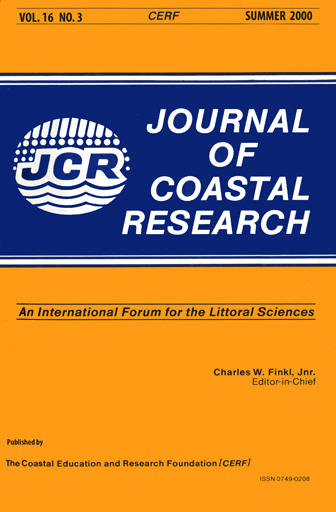Bottom Currents and Sediment Transport in Long Island Sound: A Modeling Study
Keywords:
Long Island Sound, estuaries, modeling, currents, tides, sediment transportAbstract
A high resolution (300-400 m grid spacing), process oriented modeling study was undertaken to elucidate the physical processes affecting the characteristics and distribution of sea-floor sedimentary environments in Long Island Sound. Simulations using idealized forcing and high-resolution bathymetry were performed using a three-dimensional circulation model ECOM (BLUMBERG and MELLOR, 1987) and a stationary shallow water wave model HISWA (HOLTHUIJSEN et al., 1989). The relative contributions of tide-, density-, wind- and wave-driven bottom currents are assessed and related to observed characteristics of the sea-floor environments, and simple bedload sediment transport simulations are performed. The fine grid spacing allows features with scales of several kilometers to be resolved.
The simulations clearly show physical processes that affect the observed sea-floor characteristics at both regional and local scales. Simulations of near-bottom tidal currents reveal a strong gradient in the funnel-shaped eastern part of the Sound, which parallels an observed gradient in sedimentary environments from erosion or nondeposition, through bedload transport and sediment sorting, to fine-grained deposition. A simulation of estuarine flow driven by the along-axis gradient in salinity shows generally westward bottom currents of 2-4 cm/s that are locally enhanced to 6-8 cm/s along the axial depression of the Sound. Bottom wind-driven currents flow downwind along the shallow margins of the basin, but flow against the wind in the deeper regions. These bottom flows (in opposition to the wind) are strongest in the axial depression and add to the estuarine flow when winds are from the west. The combination of enhanced bottom currents due to both estuarine circulation and the prevailing westerly winds provide an explanation for the relatively coarse sediments found along parts of the axial depression. Climatological simulations of wave-driven bottom currents show that frequent high-energy events occur along the shallow margins of the Sound, explaining the occurrence of relatively coarse sediments in these regions. Bedload sediment transport calculations show that the estuarine circulation coupled with the oscillatory tidal currents result in a net westward transport of sand in much of the eastern Sound. Local departures from this regional westward trend occur around topographic and shoreline irregularities, and there is strong predicted convergence of bedload transport over most of the large, linear sand ridges in the eastern Sound, providing a mechanism which prevents their decay. The strong correlation between the near-bottom current intensity based on the model results and the sediment response, as indicated by the distribution of sedimentary environments, provides a framework for predicting the long-term effects of anthropogenic activities.


